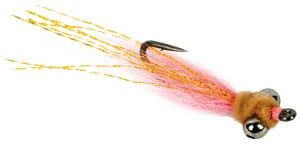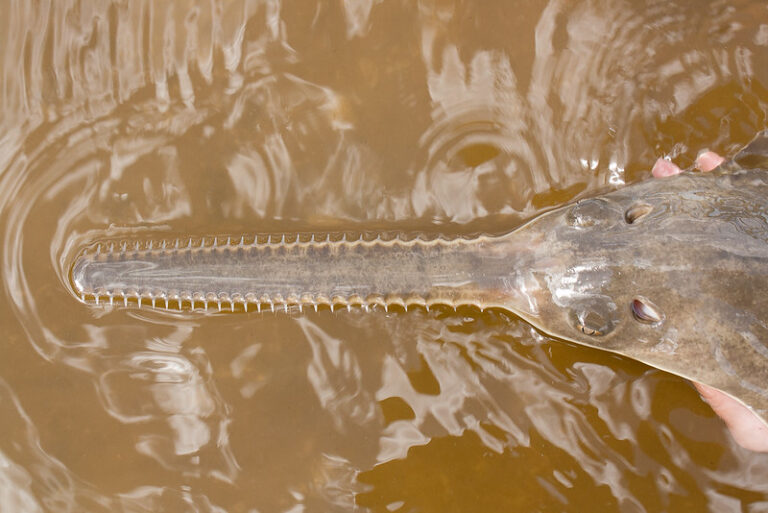
We saltwater tiers are sometimes a little slow in mining the wisdom of our freshwater brethren. There are centuries of flies from the trout, warm-water and salmon/steelhead worlds, but we sometimes ignore those resources and all they offer.
Northeastern tier David Nelson first pulled my coat to techniques and materials from the Spey fly and Dee fly world. His striper patterns are a beautiful hybrid of practical, real-world flies and the flowing grace of traditional anadromous patterns. That trend is continuing, with saltwater tube flies and striper and tarpon patterns using materials and methods typically reserved for steelheaders. It’s a fruitful marriage, one that can open doors to fresh new saltwater patterns and useful tweaks on existing recipes.
We’ll focus here on arctic foxtail fur, a staple material in tube and salmon/steelhead flies. While by no means unheard of in the salt (fox has found its way into redfish flies, tarpon Toads and Clouser variations), the material potentially has much broader applications.
The Un-Feather and Un-Fur
On websites and in catalogs, arctic foxtail is routinely referred to as a “marabou substitute,” but the comparison is misleading. Although both materials move wonderfully in the water, foxtail is very different, and in some respects, more versatile and durable.
Unlike marabou, arctic foxtail is a dense, highly tapered fur with long, substantial guard hairs. Depending upon the tail, the guard hairs represent roughly 50 percent of the total package, and they are among the best-tapered hair you’ll find on any material. Foxtail guard hairs also have a natural sheen and, on certain tails, a hint of translucence reminiscent of polar bear hair. Like bucktail, the guard hairs have just enough stiffness and structural integrity to retain their basic shape, but they are supple enough to move with every twitch of current or stripping action.

Hiding beneath those guard hairs is dense underfur. Unlike some other fur products, such as fox body fur or Finnish Raccoon (another popular steelhead material), the underfur tends to be longish, sometimes one-half to three-quarters the length of the guard hairs. It varies from coil-like and a little coarse to silky smooth and provides a lot of fluff in a small package. Even though the fur is much softer than the guard hairs, the combination of hair and fur moves as a unit in the water, making it easy to represent a wiggly tail or crab claws on the attack.
The underfur operates differently than other furs used in saltwater flies. The popular and effective bunny strip is a good counterexample. Rabbit strips are tied in attached to the hide. As effective as they are, rabbit strips – and particularly the hide – absorb a tremendous amount of water and can impede casting and create fouling issues in lengths much greater than a few inches. In contrast, foxtail fur is tied in as a clump of fur separated from the hide, so there is no thick leather to soak up water and add undue weight. Additionally, foxtail is incredibly compressible, so it’s possible to tie in a sizable chunk with almost no bulk. The result is a fairly large profile with little actual mass.

There are many excellent suppliers of foxtail, but two warrant particular mention. Eumer Products, a Finnish manufacturer of tube-fly components widely available in U.S. fly shops, offers a broad range of foxtail pieces (sometimes called medallions) in three different sizes (2x, 2.5x and 3x), ranging from a few inches to over 4 inches. Because Eumer’s medallions are neatly packaged in small, pre-sized pieces, they represent a great way to obtain a wide variety of colors and sizes inexpensively. High-quality fur can be snipped from the evenly cut strips with virtually no waste.
Another excellent source is the British supplier Foxy-Tails (www.foxy-tails.co.uk), which sells online via eBay and readily supplies U.S. tiers. The company’s proprietress, Sue Billows, says it offers three species of “polar” fox, in quarter, half or full tails. Blue fox is a shorter, coarser hair with some darker coloration in the guard hairs. It makes excellent short wings and feelers, such as on Crazy Charlies. Shadow fox is also shorter, but it is pure white and dyes to vibrant colors, and it has a very silky, fine underfur, excellent for tails on small baitfish patterns. Finally, the cream of the crop is marble fox, with soft fur up to 4-plus inches and nearly translucent guard hairs that make excellent larger-profile baitfish. All grades are useful and offered in a dizzying range of colors.
Applications and Tips
Foxtail is a ready substitute for more familiar materials on many basic patterns. For bonefish flies, shorter foxtail makes a great wing on a Crazy Charlie, Gotcha or Mini Puff. Because of foxtail’s natural taper and compressibility, it’s actually easier to tie in than traditional calf tail or craft fur, and it moves wildly in the water. Toad-type patterns can benefit from a tail made of fox, which will pulsate and breathe even when the fly is stationary. Another great application is for the tail section of a Popovics Surf Candy, akin to the bunny-strip Candies popular for albies. A Candy with a tail of fox, topped by Ultra Hair and some Bodi-Braid on the shank, has become one of my favorite flies for the fall run in Montauk, New York.
But moving beyond traditional patterns offers even more options. A series of foxtail high ties along the top of a hook shank can create tapers for all kinds of baitfish patterns, from skinny sand eels to wide-profile bunker, butterfish and pilchards. Make eachapplication slightly longer as you approach the hook eye, and blend in some Angel Hair for subtle flash. Alternatively, for a 3-D profile, tie in tapered clumps on the top and bottom of the shank for a thick-bodied mullet or round mackerel, and then coat the head of the fly with a flexible glue, like Tuffleye Flex. Foxtail also makes great tapered tentacles and fluttering swim fins on squid patterns, replicating the two most mobile areas of a squid.
There are a few tips that can help you with your first fox forays. First, when handling a clump, grab the guard hairs by their tips, and with your other hand, preen out a little underfur to get the density and hair-to-fur balance you need. Second, always use a small metal comb to brush and align the fibers after they are tied on the hook shank. Repeated combing will thin out some of the dense underfur and will blend colors and create tapers easily.

Third, while most foxtail is usually in the 2- to 4-inch range, the hair is often longer than it appears. When removing a piece, tightly separate a clump with your fingers, preen away all surrounding fibers, and dig as deep as possible with fine-tip scissors to cut cleanly down to the hide. You can add nearly an inch of length this way.
Fourth, use not only the natural taper but also the inherent curvature of the guard hairs to create toppings on baitfish patterns. Many foxtail guard hairs have just the right radius to sketch the outlines of a baitfish back, so be sure to tie the fibers down with the proper alignment and curve and comb them into a smooth taper.
Finally, because foxtail is so soft and mobile in the water, it can be prone to fouling, especially when tied right at the bend of the hook. A mono-loop snag guard works, but a swipe of flexible glue like Softex or Soft Body just past the hook bend usually does the trick.









